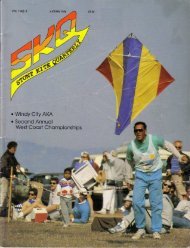Untitled - KiteLife
Untitled - KiteLife
Untitled - KiteLife
- No tags were found...
Create successful ePaper yourself
Turn your PDF publications into a flip-book with our unique Google optimized e-Paper software.
Lee Sedgwick is from Erie, Pa ., andflies both individually and as amember of Team High Fly. He isgenerally credited with being thefirst to perfect the style termed"solo flying" (i.e ., flying through aground stake) . Lee is a highly innovativeflier whose credits include: ECSKC II, 1st in IndividualBallet - , 1987 AKA National, 2nd IndividualBallet; and most recently,ECSKC III, 1st Innovative FreeFlight; 2nd in Individual Ballet; and1st (along with team member SueTaft) Open Team Ballet .KITESKIING!WINTERTIME . . . time to put awaythose stunters and dream of springand March breezes . . . right? Formost, the season of ice and snowis that period when we pursueother hobbies, take vacations towarmer climes, or just plainvegetate until the sun gets a littlehigher in the sky . These chilly days,which are unknown to those whohave chosen to live in more temperatezones, are sometimes avery harsh reality in the northernpart of the country. But packaway the kites? NEVER!An open field of snow can bean open invitation to the more inventiveflier. Admittedly, it's notthe sort of thing that everyone isgoing to enjoy but few that havetried it will dispute that it is a totallyinvigorating experience . . . and it'sreally fairly easy to begin . Juststrapping on a pair of skis, wearingthe appropriate clothing, and agood stunt kite is all one needs tobegin exploring this new realm offlight possibilities . Let's start withsome of the basics with a look atwhat you need to keep warm .Dressing for a day of kite skiingcan be looked at as one would ifone were preparing for any wintersport . . . prepare for the cold .Don't forget : the fact that you willbe moving will contribute substantiallyto the amount of wind chillthat you will experience . Layers ofinner clothing under a nylonjacket (and pants if you havethem) is a good beginning pointfor the first expedition . You cangauge upwards or downwardsfrom there . Don't forget thegloves! In cold conditions, bodyextremities will be the first thingsaffected and you'll need to keepthose fingers warm after usingthem to tie knots and work clipsbarehanded .Protective headgear is alsorecommended . Even a small kitecan exert enough force to pullyou along once the ground frictionof the flier is reduced . . . this isparticularly in evidence whenflying on ice, which presents almosta zero resistance factor .Padding is also a good idea . Likeanyone learning something for thefirst time, it's wise to prepare tomeet anticipated problems in advance. . . plan on falling! That softbed of snow can conceal allmanner of things beneath as wellas being darned hard on top . . .(which can be darned hard onthe backside, as well!) .Next, you'll need a pair of skis .The best place to find these, unlessyou want to spend a realbundle of cash, is at the localsecondhand store . Even ski shopssometimes will make deals onused equipment . About $30should put you on a good pair . Ohyes, you'll need a set of boots togo along with them . Local skishops should be able to adviseyou here but they are availablesecond hand, as well . Be sure toset the bindings for light release . . .it beats the heck out of a twistedankle or broken leg!OK . So you're all dressed up andfeeling like and Egyptian mummy. . . no what do you do? Simple,launch the kite in the usual way,keeping in mind that you'll need alot of room down field and . . . alittle traveling music, maestro! . . .you're on your way!Remember, the basic rules ofpowerflying apply here . . . kites intothe power zone will move you faster,off wind and you'll slow down .A little practice and you should beable to maneuver, after a fashion,sideways, like a sailboat on a tackingrun . Remember to keep yourknees bent, this may seem an oddposition a first but as your legsbegin to absorb some of the terrainbumps and differences in kitepull, you'll see why the position isneeded . Take a portable musicsource with you and kite skiing willtake on a whole different aspect .Most interesting is the fact thatyou're not tethered in one spotany longer . . . the interaction betweenkite and flier is noticeablyincreased .If this is your first experience withkite skiing, you'll probably find outsomething else . . . that you reallyweren't aware of how much pullthose kites generated! . For thisreason, it's wise to begin with a lotless kite than you think you mightneed . More can always be addedif needed but, keeping safety inmind, it's a lot easier to find thatyou can handle more speed thatbeing stuck with too much andbeing out of control . And speakingof control . . .Don't expect to become a masteron the first trip out . Keep itsimple and slow : there's plenty oftime for blazing speed later . . .learn to stand up first, walksecond, and run third before worrying about the soaring witheagles .As with any other form ofpowerflying, check your equipmentoften . Breaking a line orhaving an equipment malfunctionis nothing to fool with when bothflier and kites are in motion . 200Lb . is a must : 400 lb . for heavierpilots . While Spectra line is OK,there are some inherent problemsinvolved with its use . Probably thebiggest single drawback is that itcan't readily be seen against thesnow . Kevlar seems to be the lineof choice for this particular brandof powerflying . 150 feet is recommendedas a good starting pointof length . As your lines will be subjectto some adverse conditions,not the least of which is other folksrunning over them, make sure toinspect them often for fraying orother damage . Don't forget, aswith any other form of powerflying,your margins of safety arewhatever you choose to makethem!
















